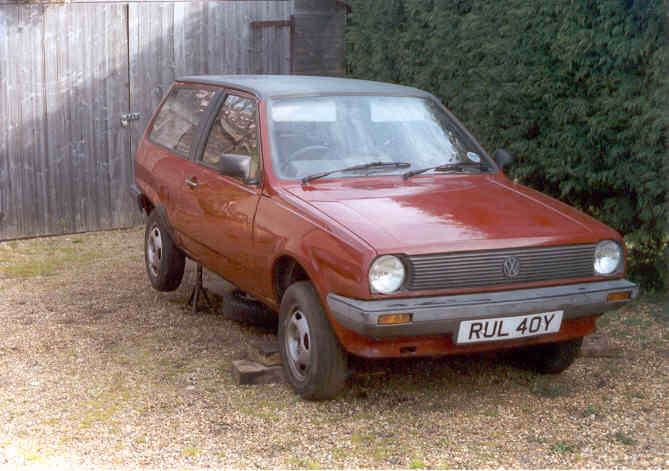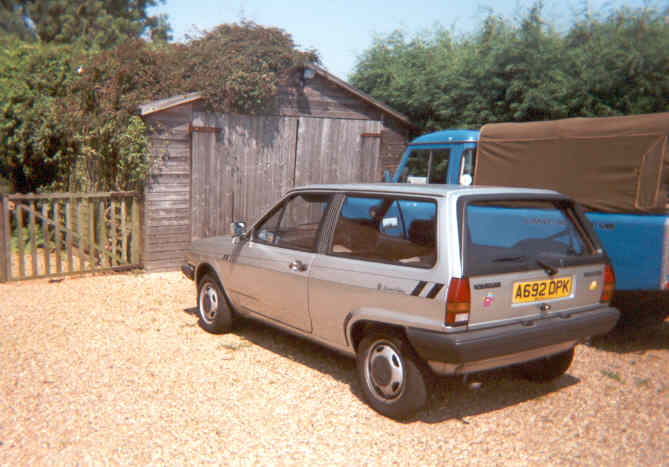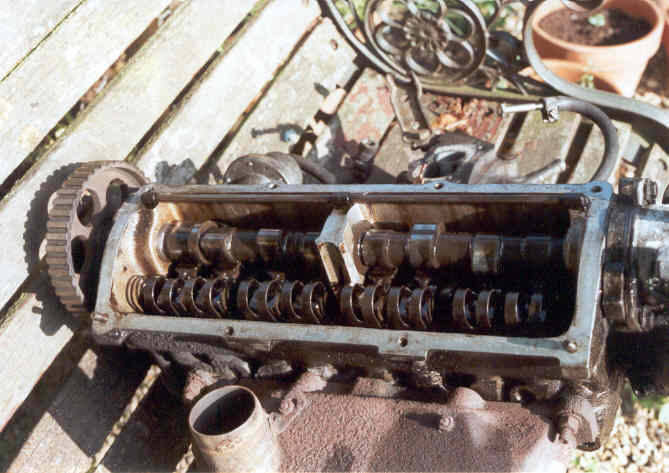![]()
The New Morris Minor (updated Feb 04)

I dragged this out of someone's garden. Doesn't look bad for a free car, does it?
Twenty years ago, if you wanted ultra cheap, simple, reliable, practical transport for little money, there was a good chance that you'd end up with an old Morris Minor. They were tough, simple little cars which cost very little to run, and even a twenty year old example usually had a bit of life left in it. Most sought after was the hugely practical wood-framed Traveller estate, and the van version was very popular as well. Much loved by nurses, teachers, poor students, old ladies who bred spaniels, and people with horses to feed, the Minor was for many years the definitive British banger.
Nowadays of course, the surviving Minors have attained classic car status, with prices to match. If you want a decent, usable Traveller, you will be lucky to find one for under £2,000. A solid but slightly scruffy saloon might go for half that. Until recently there didn't seem to be anything to replace the Minor as indestructible bargain-basement transport, but gradually a replacement has emerged - the Mk2 VW Polo.
Just think about it for a moment. Economical, sturdy, cheap to tax, insure and maintain, hugely practical and lots of them about. Try this test - next time you are in your local supermarket car park, see how many pre 1985 cars (C registration or earlier) there are. Fiestas? Metros? All long gone, but I bet there will be a few Polos about. It's all down to rustproofing. Polos had it, their competitors didn't. And that's why the Polo is the new Morris Minor. They are deeply unsexy and unfashionable, no-one wants them because they are so old, but you won't find a more practical and durable car anywhere else for so little money.
I don't think the Polo will ever inspire the same depth of affection as the Minor. It's a bit, well, German, austere and efficient rather than charming and cuddly. I can't see specialists up and down the country tooling up to produce floorpan repair sections, or offering fully restored, updated Polos as an alternative to a modern car. (Although having said that, there is a growing Owners' Club - www.vwpolo.co.uk)The Polo inspires quiet respect, rather than any deep affection. But there are plenty of owners out there who are proud of their little Polos as they head towards 20 years and 200,000 miles without showing any real sign of impending death. For the motorist on a tiny budget, there really is no better car available today.
As you might expect, the Polo hasn't generated an awful lot of useful Web-based information, so I have attempted here to fill the gap, based on my own experiences with these cars. This is not intended to be the complete and definitive guide to Polo purchasing, and I would greatly welcome suggestions from other Polo owners to fill in some of the gaps. So if you buy a Polo based on this guide, and it turns out to be a dog, please don't blame me. Remember, all the usual rules for buying an old car still apply, so take plenty of time to inspect the car, and if you don't feel you know enough about cars to spot a bad one, bring in someone who does.
Model range
3 body styles. Hatchback the most common, actually more of a mini-estate with the squared off rear end, and a worthy successor to the Morris Traveller. Rear seat folds down giving lots of room for carrying things. 'Polo Classic' had two door saloon body - decent size boot, but never very popular and only worth having if in beautiful condition and very cheap. 'Coupe' was just a 3-door hatch with a sloping tailgate - some sporting pretensions (spoilers, extra driving lights etc), but only very late cars had a decent amount of power. Engines are 1043cc (40 bhp), 1093cc (50 bhp) or 1272cc, with either 4 or 5 speed gearbox. 1.3 usually 55 bhp, but late Coupe GT had 75 bhp. G40 had 113 bhp, but a very specialised motor car and not really what this article is all about. Various trim options, from 'C' (base model), through the slightly plusher Fox, CL and GL, to the reasonably well equipped Ranger (as in Sloane Ranger - VW really had the Kensington debutante market sewn up with this one). A few special editions to confuse matters - I once had an LX (GL with different seat trim and side stripes), which isn't listed by any of the major insurers or price guides. Best bet as an only car is a 1.3CL or Ranger, 1986-90 - the bigger engine and 5 speed box make a big difference - but there are no real dogs in the range, although the 1043cc Coupe is a bit laughable. Insurance - 1043 and 1093 are group 4, 1272 is group 6. Supercharged G40 is group 16..... Range was facelifted in 1990, with rectangular headlamps, better interiors and a minor restyle at the back. These later cars were built in Spain, and I have heard suggestions that the quality is not as good, but all the examples I have seen look fine to me, and a friend got 190k out of one with no trouble, so they can't be that bad.

Another bargain Polo - lots of dents, but no rust, even though it's old enough to be able to vote.
Bodywork
Polo bodywork is very tough, the result of good quality steel, plenty of rustproofing wax and seam sealer applied at the factory, and decent paint. However, if the car has been in an accident, the rustproofing on the repaired section is unlikely to be as good as the rest of the car. Also the seam sealer will crack with age, water gets in underneath and the rust will spread unseen until it has done some major damage. Precisely because of the liberal use of seam sealer, Polos are more vulnerable to this than most cars, so check very carefully. Major rust spots are likely to be:
Rear wheel arches, around wheelarch lip and inside wheelarch itself. Drivers side has a major mud trap where the petrol filler pipe passes through - if this area is not hosed out regularly, rust can eat through the wheelarch, inner wing, sill end and petrol filler pipe. This is a major job to repair. If there is any sign of rot at the rear end of the drivers side sill, the hidden area behind it will be much worse.
Rear seatbelt mounts - the area around the mounting plates can rot, which is an MOT failure point. Lift the rear seat to check.
Front wings - these have plastic liners, but can go frilly at the bottom, especially if the drain holes become blocked.
Battery tray - worth removing the battery to look for rot in this area, as it can easily spread to the inner wings and bulkhead.
Boot floor - especially around the base of the rear suspension turrets and inside the spare wheel well. Cracked rear light lenses will cause the boot to fill with water, which soaks the carpets and allows the rot to take hold.
Windscreen surround can rot at the lower corners, leading to leaks.

Simple valve clearance adjustment by Allen key. Polo engines are easy to work on - even for major jobs like head removal.
Engine/gearbox
Main problems to look out for - oil leaks due to either bore wear or blocked crankcase breather, noisy tappets (can usually be adjusted), head gasket failure quite common on very old examples. Cambelt should be changed at 60K, and the water pump inspected carefully - it is driven off the cambelt, and if it seizes, it will break the belt and wreck the engine. Engine mounts get tired, leading to clutch judder on moving off from rest. Carburettor is mounted on a rubber block which can split, resulting in erratic idling. Earlier Polos had contact breaker ignition which needs regular maintenance - later electronic ignition is maintenance free, but cannot easily be retro-fitted to earlier cars, as the distributor mounting is different. Cooling system fairly robust, but temperature switch for cooling fan often fails, leading to overheating and possible engine damage. Gearboxes near enough indestructible (they don't have to handle a lot of power) but inner driveshaft joints can fail when the grease in them solidifies due to old age. Heavy clutch is probably due to a worn clutch cable - replace quickly before it breaks and leaves you stranded.
Suspension, steering and brakes
Suspension is very simple and easy to work on. Rubber bushes in front suspension arms have a limited life, and are almost impossible to replace - much easier to change the whole arm (£25 per side). For the technically minded, front suspension is one of very few examples of a pure McPherson strut design, with the anti-roll bar used to locate the lower suspension arm. The design puts a lot of stress on rubber bushes, which is why so few cars use it. Rear shock absorber bushes likely to be perished on older cars - you can't buy the bushes separately, but complete shock absorber units are around £14 per side. Brakes are also very simple, but have no servo assistance (except for post 1990 facelift cars), so much heavier than a modern car. Rear brakes need careful assembly for the self-adjusters to work, or you end up with excessive pedal travel. Parts are ridiculously cheap, so don't cut corners or muck about with second hand bits. Due to the sheer old age of these cars many braking components, especially the rubber hoses, will be a long way past their 'best before' date, but new hoses are only £6 a corner, rear wheel cylinders the same, and the front brake calipers and master cylinder (the expensive bits) usually last well. Rear wheel bearings are often over-tightened to try and eliminate play, leading to failure. Replacements are cheap but a bit tedious to fit.

This was a rear wheel cylinder. Cars this old can be hiding some nasty surprises in the braking department.
Electrics
Generally good quality components, most problems are caused by dirty connectors. Cooling fan can seize through lack of use if the car only ever does short journeys, and heater fan can give problems if the plastic guard above the motor is split or missing. Headlamps are feeble, especially the tungsten ones on early base model cars. Many Polos are fitted with grille-mounted driving lamps, Golf GTI style, which make a big difference at night. Alternators tend to die at around 100k.
Interior and fittings
Seat covers fall apart with age, but the seats themselves are pretty tough. The rest of the interior is almost everlasting. Tailgate struts weaken on older cars, so the tailgate falls down and hits you on the head. Exterior door handles are the usual VW rubbish, but cheap and easy to replace. Locks wear, especially the tailgate lock which can be very fiddly to open. You don't get a lot in the way of toys - no central locking, electric windows or power steering. Models from CL upwards have a rev counter, but that's as good as it gets.
DIY considerations
Generally the Polo is about as easy to work on as any car of its era, although there are a couple of real pig jobs (crankcase breather and fuel tank replacement will both have you swearing). Cheap parts from places like German & Swedish - front brake pads for a fiver, rear wheel cylinders £6 each, £4 for a cambelt, etc. Most jobs can be tackled without any special tools, but cylinder head bolts and inner driveshaft joints use 12 point splined socket screws, and tappet adjustment requires a 7mm Allen key, which isn't a size which comes in most sets. If the worst happens, you can have the engine and gearbox out in a couple of hours - they have to be lifted out together, due to restricted space at the cambelt end of the engine. Service intervals are theoretically 10,000 miles, but if you want your Polo to last, change the oil and filter at 5,000. Polos are currently plentiful in scrapyards, and likely to remain so for quite a while. At present only the really old cars (1982-85) are being scrapped in large numbers, which leaves another nine years' production still to find their way to the breakers.
How much to pay
Not a lot. A quick scan through the local paper turned up a dozen Polos, with prices ranging from £125 (1984 1050 C, short tax and MoT) to £1,195 (low mileage 1990 Ranger with full VW service history). Older cars really are almost worthless, and anything pre 1986 shouldn't cost you more than £300 unless it is unusually good. My last Polo (1983 1.1C Formel E) was free, and its predecessor (1984 1.3LX) cost me £21, although in both cases I had to spend a fair bit to get them roadworthy (click here for the full story on my previous Polo). Later facelifted cars fetch a bit more, but probably not really worth paying the extra when the older ones are so durable. If you choose your Polo carefully, and look after it properly, it should last almost indefinitely.
Postscript: A guy called Simon emailed me with some more useful information. I always meant to update the article to incorporate this, but never found the time. So here is what he sent me - thanks Simon.
1. I wouldn't call the Ranger "well equipped" - it had no extras bar those mentioned above. No rev counter or the GTi lookalike red trim on the dash :-( Engine spec is very similar to the old car, but engine no. (2G) suggests there are changes. Of course, electronic points and self-adjusting tappets are nice, though I fitted an aftermarket item (Pertronix Ignitor) to the old 'un which worked like a dream.
2. I think you were a bit unfair on the Derby/Polo Classic. It had a boot, but was a Polo in all other respects. Just like the Jetta, it's invariably a bargain, if a booted car is what you want. The boot is quite big, too.
3. I clean the rear wheel arches with my fingers, and then use the hose on them and around the petrol filler area you highlighted.
4. Head gasket went at 155k on the old car (better than most makes), but on the new one it started leaking oil externally at just 80k. My guess is that, being a low mileage car, it actually suffered from insufficient use (a guess - my mum covered ca. 25k in 5 years).
5. Polos often leak oil onto the alternator, shortening its life - either from Head Gasket or Rocker Cover Gasket. Worth watching for on a regular basis. VAG dealer's price on a replacement alternator was only £5 more than some cheap & nasty-looking QH item. It wasn't Bosch but lasted well. I'd not long had another before selling the car, but it was not compatible with the new car's wiring so unfortunately I couldn't transfer it.
6. Front wheel bearings last 80-90k. My regular garage quoted a fixed price repair of about £55 per wheel. They're quite awkward to do IIRC.
7. Headlamps on the A-reg were fine (better than Mk3 & Mk4 Golfs), though the Y-reg 1043cc my parents had before the Ranger was a different story. Rather weak, like the 40bhp engine. It cruised fine, even on the motorway, but accelerating certainly wasn't its forte. Adequate cheap no-frills transport, though. The extra illumination on the Ranger is great, and the bulbs are an entirely different shape.
8. As it's a 2-door, the seat cables will stretch or break, and are fiddly to replace. I used a piece of stiff plastic tubing from the seat trim to guide the new cable through the seat (after removing the seat from the car). No, I didn't pull the seat apart, this tube had been sticking out for ages. It was just the thing to get that wire down the inside of the seat. Serendipity! A more fastidious owner would have snipped it off long before and missed out.
9. The tailgate strut went on the old car, and the mounting had rotted so I couldn't get a secondhand part - had to buy new.
10. I've fitted mudflaps to the new car, to help save the bodywork. Recommended. On the wheel where a rear flap was missing the old car had a big rusty patch - just behind where the flap would have been. Being a coupe, it had plastic wheelarch guards, which were a real boon.
11. I think changing oil at 5,000 miles is unnecessary. I changed the oil every 10,000 miles or so between 72,000 and 190,000, and even when I said goodbye she was running fine. T'was a sad day. The guy even commented on how good it sounded. I reckon one reason was because I was doing 50-90 miles a day.
12. One benefit of the Coupe was that the baby car seat I bought fitted in the 'normal' way. With the belt mounting points being further back on the estate, I had to use Britax's alternative (and considerably more awkward) seat belt routing.